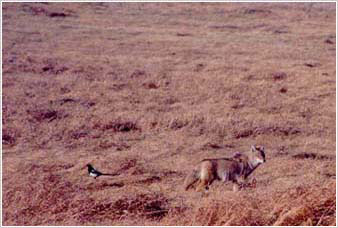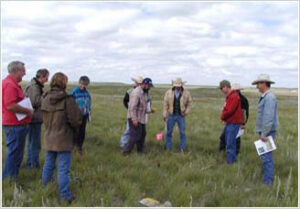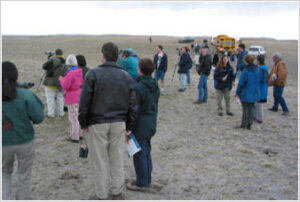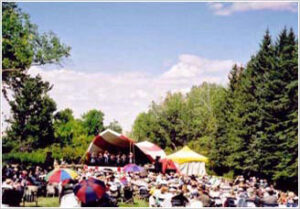Susan Lingle came to southern Alberta in 1993 to work on her doctoral thesis through the University of Cambridge, England. She had obtained permission from Parks Canada to do her studies at Waterton Lakes National Park. While visiting with local Fish and Wildlife officers, Susan learned of the McIntyre Ranch. It was at this point we got a call from Susan. She shared with us what she was attempting to achieve and wondered if the possibility existed for her to do her research at the Ranch. We thought it might work just fine so it was then up to her to decide where she would study. It was agreed that she would spend one week in Waterton and one week at the Ranch and then make her decision.
After those two weeks, Susan spent the next three years living and researching on the Ranch. She then returned to England and received her Doctorate and then returned back to Lethbridge where she currently conducts postdoctoral research at the University of Lethbridge and the University of Alberta. Susan (with the help of others) continues to do research on the Ranch today. We consider ourselves very fortunate to have someone like Susan, who is willing to take the time to learn (and teach us) more about the deer, coyotes, ground squirrels etc. on the McIntyre Ranch.
Comments by Dr. Susan Lingle
came to the ranch when searching for a field site for my Ph.D. work on white-tailed deer and mule deer. Once I saw a group of whitetails, a notoriously secretive species, ambling across the open prairie, I knew this would be an exceptional place for an observational study. Within two weeks of arriving at the McIntyre, I saw a few attempted and actual predations by coyotes on deer, events that are rarely witnessed elsewhere. My early thought about the McIntyre, “this must be what the grasslands of North America must have once been like!”. I have been able to discover many things about the behavior and ecology of coyotes and deer because of the number of animals and unsurpassed viewing conditions found at the McIntyre.
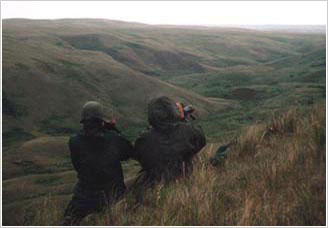
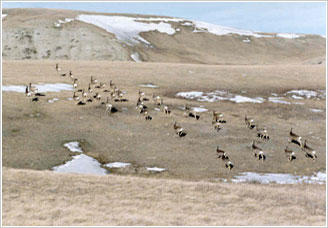
Coyotes form packs that go on extended hunts during which they hunt deer. These hunts are similar to hunts of wolves, although shorter in length. I sit at vantage-points from which I try to watch coyotes from the start to the end of a hunt. I sit far from the animals but use high-powered spotting scopes. I focus on the way in which the deer’s behavior (for instance, does it fight or flee) and habitat influences the coyote’s success in getting a meal. With help from field assistants and volunteers, I also conduct regular censuses of the coyotes and deer and monitor the survival of fawns that are ear-tagged in June.
Following my Ph.D. (Zoology, University of Cambridge), I returned to Alberta to continue my research on coyotes and deer at the McIntyre. Currently I am a postdoctoral fellow at the University of Lethbridge and the University of Alberta. I am grateful to the Thrall family for the opportunity to do this work and to the families working and living at the McIntyre for extensive assistance in these projects.
The Deer
Whitetails and mule deer are closely related and similar species of deer. They are similar in size, they eat the same foods when given a choice, they breed and give birth at the same time of year, and they can even produce hybrid young. One important difference lies in the habitats they use in winter. Mule deer tend to use more open and rugged terrain, and whitetails are found in more gentle habitats with more cover. Nevertheless, both species occupy a wide range of habitats and frequently coexist, as they do in portions of the McIntyre.
Another important difference lies in their responses to predators (their anti-predator behavior). During winter, the mule deer’s first line of defense is to stay in rugged terrain. Coyotes travel in gentle terrain when hunting deer so rarely encounter mule deer that stay high. If mule deer are encountered, they typically stand their ground and bunch closely together. As long as they bunch together, coyotes are unlikely to make an attack or a kill. If coyotes find a fawn or even an adult to attack, adult females in the area will come to defend it, striking the coyote with their fore hooves. Instead of confronting coyotes, whitetails flee when attacked. They escape by outrunning coyotes with no assistance from other deer.
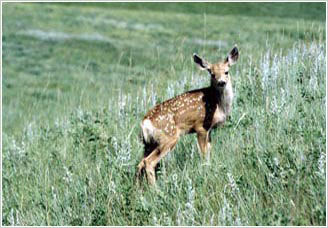
Current projects
(1) Cooperation in mule deer. Mule deer mothers band together to defend a wide web of fawns during summer, not only their own offspring. In fact, they are even willing to defend whitetail fawns that are attacked by coyotes. I am currently investigating why they are willing to defend such a wide web of unrelated animals, with the goal of adding to our understanding of cooperation in animals.
Fawns let out a loud “bleat” when they are attacked by coyotes. I recently recorded these cries to find out whether cries made by whitetail and mule deer fawns sound the same, which could explain why female mule deer respond to fawns of both species. It turns out there is a big difference in pitch between their cries (listen to the cry of a whitetail, cry of a mule deer). We are now in the process of playing calls back to females to see how they respond to calls made by their own fawn, and to calls made by unfamiliar fawns of the two species.
This project is being supported through a Postdoctoral Fellowship from the Alberta Ingenuity Fund and is being done in collaboration with Sergio Pellis and Drew Rendall from the University of Lethbridge, and with Mark Boyce from the University of Alberta.
(2) Effect of alternative prey on predation on deer. Ground squirrels are the prey of choice for coyotes at the McIntyre. As long as ground squirrels are abundant, coyotes spend little time hunting deer. This means that, in many years, coyotes mostly hunt deer in winter when ground squirrels hibernate and are under ground. I am monitoring coyote, deer and ground squirrel numbers to find out how variation in the abundance of ground squirrels and other prey (voles, rabbits) influences the amount of deer captured by coyotes in different years.
This project is primarily funded by Alberta Conservation Association and Alberta Sport, Recreation, Parks and Wildlife Foundation. Finbarr Wilson has participated on the coyote-deer work for several years as a field assistant and is currently conducting censuses for this project. For more information or publications, contact: Susan Lingle.
Alberta Conservation Association
Alberta Ingenuity Fund

